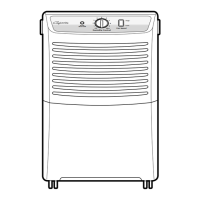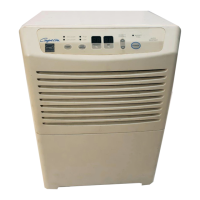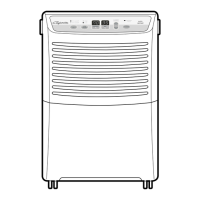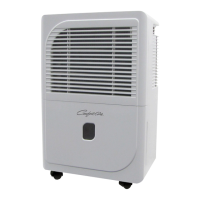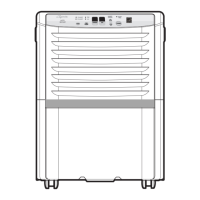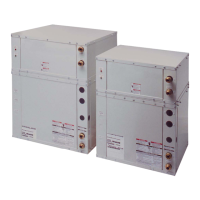Do you have a question about the Heat Controller BHD-301-G and is the answer not in the manual?
Essential safety guidelines for servicing the unit, including power disconnection and testing.
Procedure for conducting an insulation resistance test to ensure user safety after servicing.
Highlights key functionalities such as auto-defrosting, wide temperature range operation, and display.
Identifies the location and function of all control buttons and indicator lights on the unit.
Provides the physical dimensions (width, height, depth) for different dehumidifier models.
Explains how to set the desired humidity level and the continuous dehumidification mode.
Details how to adjust fan speed for optimal moisture removal or quieter operation.
Describes the auto start and auto stop timer functions.
Explains the information shown on the unit's display regarding humidity and timer settings.
Lists and explains common error codes displayed by the unit.
Specifies the recommended environmental conditions for optimal dehumidifier performance.
Step-by-step guide for powering the unit on, off, and initial self-check procedures.
Details how the unit operates with its internal water tank and the full tank indicator.
Instructions for connecting and using the continuous drainage hose.
Important safety advice before cleaning or performing maintenance on the unit.
Steps for removing, cleaning, and drying the air filter for efficient operation.
Guidance on cleaning the exterior cabinet of the dehumidifier.
Instructions for washing and drying the water collection tank.
Describes the unit's self-diagnosis process upon initial power-up.
How to adjust humidity settings and the compressor/fan cycling behavior.
Details on operating the unit in continuous mode and its fan operation.
Procedure for turning the unit off and its subsequent actions.
Information regarding the 3-minute time delay for compressor restarts.
Explanation of unit protections like water-full, anti-icing, and sensor failures.
Methods for testing compressor windings, ground faults, and efficiency.
Procedure to test the external thermal overload protector on the compressor.
How to check the internal overload protector embedded in compressor windings.
List of essential tools and equipment for refrigeration system servicing.
Specifications for equipment capabilities required for refrigerant handling.
Step-by-step guide for replacing sealed refrigeration circuit components.
Procedures for addressing compressor motor burnout, including flushing and reassembly.
Specific service notes and troubleshooting tips for rotary compressors.
Critical steps for accurately charging the system with the correct refrigerant amount.
Methods for testing the fan motor's operation at different speed settings.
Procedures for testing capacitors for functionality using an ohmmeter.
Classifies troubles into starting failure, ineffective AC, and structure damage.
Specifies the acceptable operating voltage range for the unit.
Lists and explains specific fault codes displayed on the Printed Circuit Board.
Troubleshooting steps for issues with water level sensing or alarms.
Diagnosing alarms related to temperature sensors or loose connections.
Procedure to diagnose humidity sensor failures, including moisture and connectivity checks.
Flowchart for troubleshooting unit or motor startup issues.
Guide to identify the source and resolve abnormal noises from the unit.
A comprehensive list of common complaints, their causes, and suggested remedies.
Specific causes and remedies for abnormal fan motor noise.
Troubleshooting steps when only the compressor fan motor is operating.
Diagnosing and resolving issues causing reduced dehumidification capacity.
Troubleshooting when the compressor fails to turn off at the set humidity level.
Identifying causes for the unit cycling on and off too frequently.
| Product color | White |
|---|---|
| Water tank capacity | 5 L |
| Water level indicator | Yes |
| Suitable for room area up to | 139 m² |
| Suitable for room volume up to | - m³ |
| Depth | 236 mm |
|---|---|
| Width | 340 mm |
| Height | 505 mm |
| Weight | 13608 g |
